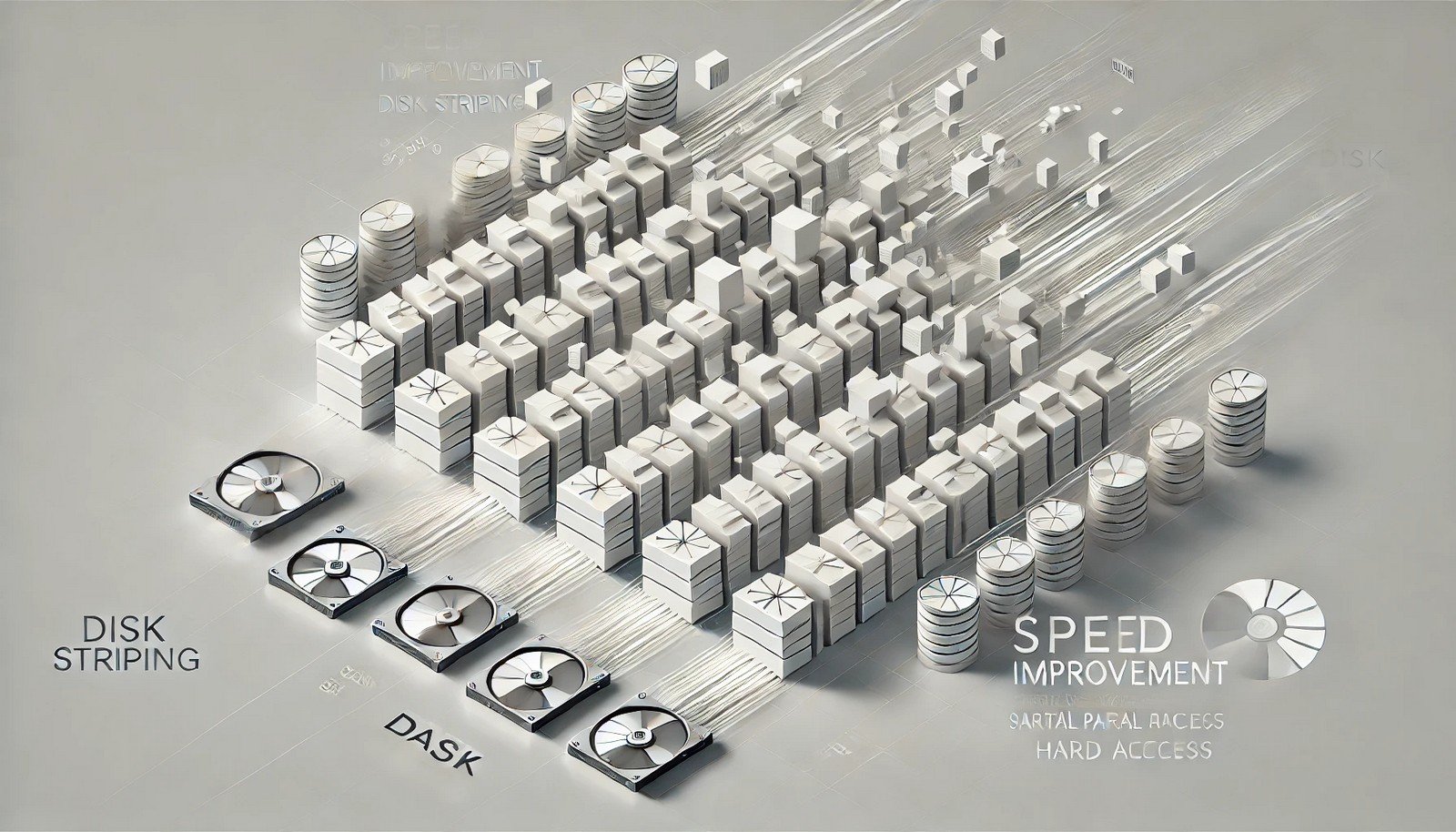Disk Striping
 (Representational Image | Source: Dall-E)
(Representational Image | Source: Dall-E)
Quick Navigation:
- Disk Striping Definition
- Disk Striping Explained Easy
- Disk Striping Origin
- Disk Striping Etymology
- Disk Striping Usage Trends
- Disk Striping Usage
- Disk Striping Examples in Context
- Disk Striping FAQ
- Disk Striping Related Words
Disk Striping Definition
Disk striping is a data storage technique that improves performance by distributing data evenly across multiple disks. It breaks data into small segments and writes them sequentially across a disk array. This allows read and write operations to be performed simultaneously on different disks, increasing overall speed. Disk striping is commonly used in RAID (Redundant Array of Independent Disks) configurations, particularly RAID 0, which focuses purely on performance enhancement without redundancy.
Disk Striping Explained Easy
Imagine you have a big book to copy, and instead of doing it alone, you and a friend divide the pages and copy them at the same time. You finish much faster! Disk striping works the same way: instead of storing data on one disk, it spreads it across multiple disks so that the computer can access different parts of the data at once, making everything run quicker.
Disk Striping Origin
The concept of disk striping emerged in the late 1980s as a response to the need for faster data access in computing. Early systems used single-disk storage, which became a bottleneck as processing speeds increased. Disk striping evolved as part of RAID technology to improve data throughput by leveraging multiple disks.
Disk Striping Etymology
The term “disk striping” comes from the way data is arranged across multiple disks in “stripes” or blocks, similar to the stripes on a zebra or a road.
Disk Striping Usage Trends
With the rise of big data, gaming, and high-performance computing, disk striping has gained popularity in environments that demand fast data access. Modern applications, such as cloud storage, video editing, and database management, utilize striping to maximize efficiency. However, because RAID 0 lacks redundancy, it is often paired with backup solutions or other RAID levels.
Disk Striping Usage
- Formal/Technical Tagging:
- Data Storage
- RAID Technology
- High-Performance Computing - Typical Collocations:
- "disk striping for performance"
- "RAID 0 disk striping"
- "data striping across multiple drives"
- "improving read/write speed with striping"
Disk Striping Examples in Context
- A video editor uses disk striping to speed up rendering times by distributing files across multiple drives.
- Cloud storage services implement disk striping to enhance data retrieval performance.
- In gaming, disk striping ensures that large game files load quickly by accessing multiple disks simultaneously.
Disk Striping FAQ
- What is disk striping?
Disk striping is a technique that splits and distributes data across multiple disks to enhance read/write performance. - How does disk striping improve performance?
By allowing multiple disks to read and write data simultaneously, striping increases data transfer speeds. - Is disk striping the same as RAID?
Disk striping is a component of RAID, most commonly used in RAID 0, which focuses on performance rather than redundancy. - Does disk striping provide data protection?
No, RAID 0 (pure striping) does not offer redundancy. If one disk fails, all data is lost. - What industries use disk striping?
Industries like video production, gaming, cloud computing, and database management use disk striping for speed optimization. - Can disk striping be used with SSDs?
Yes, SSDs can also use disk striping to further boost data transfer speeds. - How is disk striping different from disk mirroring?
Disk striping spreads data across disks for speed, while mirroring duplicates data for redundancy. - What is the disadvantage of disk striping?
The main downside is that if one disk in the striped array fails, all stored data becomes inaccessible. - Can disk striping be used with redundancy?
Yes, it can be combined with RAID 1, 5, or 10 for performance and data protection. - How does disk striping benefit gaming PCs?
By loading game assets faster, reducing lag, and enhancing overall system performance.
Disk Striping Related Words
- Categories/Topics:
- RAID Storage
- Data Performance Optimization
- Computer Hardware
Did you know?
The RAID system, including disk striping, was first conceptualized in 1987 at the University of California, Berkeley. Researchers sought a way to combine multiple inexpensive disks to match the performance of expensive high-end storage solutions, giving birth to modern RAID configurations.
PicDictionary.com is an online dictionary in pictures. If you have questions or suggestions, please reach out to us on WhatsApp or Twitter.Authors | Arjun Vishnu | @ArjunAndVishnu

I am Vishnu. I like AI, Linux, Single Board Computers, and Cloud Computing. I create the web & video content, and I also write for popular websites.
My younger brother, Arjun handles image & video editing. Together, we run a YouTube Channel that's focused on reviewing gadgets and explaining technology.



Comments powered by CComment